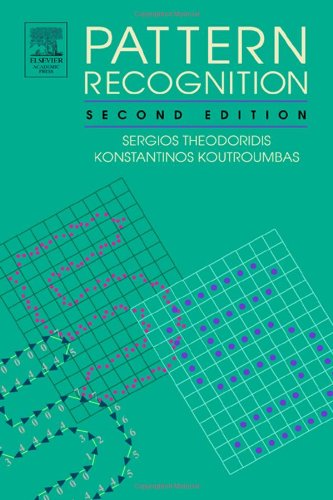

Most ebook files are in PDF format, so you can easily read them using various software such as Foxit Reader or directly on the Google Chrome browser.
Some ebook files are released by publishers in other formats such as .awz, .mobi, .epub, .fb2, etc. You may need to install specific software to read these formats on mobile/PC, such as Calibre.
Please read the tutorial at this link. https://ebooknice.com/page/post?id=faq
We offer FREE conversion to the popular formats you request; however, this may take some time. Therefore, right after payment, please email us, and we will try to provide the service as quickly as possible.
For some exceptional file formats or broken links (if any), please refrain from opening any disputes. Instead, email us first, and we will try to assist within a maximum of 6 hours.
EbookNice Team

Status:
Available4.6
15 reviews
ISBN 10: 0126858756
ISBN 13: 9780126858754
Author: Sergios Theodoridis, Konstantinos Koutroumbas
Pattern recognition is a scientific discipline that is becoming increasingly important in the age of automation and information handling and retrieval. Patter Recognition, 2e covers the entire spectrum of pattern recognition applications, from image analysis to speech recognition and communications. This book presents cutting-edge material on neural networks, - a set of linked microprocessors that can form associations and uses pattern recognition to "learn" -and enhances student motivation by approaching pattern recognition from the designer's point of view. A direct result of more than 10 years of teaching experience, the text was developed by the authors through use in their own classrooms.
Chapter 1. INTRODUCTION
1.1 Is Pattern Recognition Important?
1.2 Features, Feature Vectors, and Classifiers
1.3 Supervised Versus Unsupervised Pattern Recognition
1.4 Outline of the Book
Chapter 2. CLASSIFIERS BASED ON BAYES DECISION THEORY
2.1 Introduction
2.2 Bayes Decision Theory
2.3 Discriminant Functions and Decision Surfaces
2.4 Bayesian Classification for Normal Distributions
2.5 Estimation of Unknown Probability Density Functions
2.6 The Nearest Neighbor Rule
Chapter 3. LINEAR CLASSIFIERS
3.1 Introduction
3.2 Linear Discriminant Functions and Decision Hyperplanes
3.3 The Perceptron Algorithm
3.4 Least Squares Methods
3.5 Mean Square Estimation Revisited
3.6 Support Vector Machines
Chapter 4. NONLINEAR CLASSIFIERS
4.1 Introduction
4.2 The XOR Problem
4.3 The Two-Layer Perceptron
4.4 Three-Layer Perceptrons
4.5 Algorithms Based on Exact Classification of the Training Set
4.6 The Backpropagation Algorithm
4.7 Variations on the Backpropagation Theme
4.8 The Cost Function Choice
4.9 Choice of the Network Size
4.10 A Simulation Example
4.11 NetworksWithWeight Sharing
4.12 Generalized Linear Classifiers
4.13 Capacity of the l-Dimensional Space in Linear Dichotomies
4.14 Polynomial Classifiers
4.15 Radial Basis Function Networks
4.16 Universal Approximators
4.17 Support Vector Machines: The Nonlinear Case
4.18 Decision Trees
4.19 Discussion
Chapter 5. FEATURE SELECTION
5.1 Introduction
5.2 Preprocessing
5.3 Feature Selection Based on Statistical Hypothesis Testing
5.4 The Receiver Operating Characteristics CROC Curve
5.5 Class Separability Measures
5.6 Feature Subset Selection
5.7 Optimal Feature Generation
5.8 Neural Networks and Feature Generation/Selection
5.9 A Hint on the Vapnik–Chernovenkis Learning Theory
Chapter 6. FEATURE GENERATION I: LINEAR TRANSFORMS
6.1 Introduction
6.2 Basis Vectors and Images
6.3 The Karhunen–Loève Transform
6.4 The Singular Value Decomposition
6.5 Independent Component Analysis
6.6 The Discrete Fourier Transform (DFT)
6.7 The Discrete Cosine and Sine Transforms
6.8 The Hadamard Transform
6.9 The Haar Transform
6.10 The Haar Expansion Revisited
6.11 Discrete TimeWavelet Transform (DTWT)
6.12 The Multiresolution Interpretation
6.13 Wavelet Packets
6.14 A Look at Two-Dimensional Generalizations
6.15 Applications
Chapter 7. FEATURE GENERATION II
7.1 Introduction
7.2 Regional Features
7.3 Features for Shape and Size Characterization
7.4 A Glimpse at Fractals
Chapter 8. TEMPLATE MATCHING
8.1 Introduction
8.2 Measures Based on Optimal Path Searching Techniques
8.3 Measures Based on Correlations
8.4 Deformable Template Models
Chapter 8. TEMPLATE MATCHING
8.1 Introduction
8.2 Measures based on optimal path searching techniques
8.3 Measures based on correlations
8.4 Deformable template models
Chapter 9. CONTEXT-DEPENDENT CLASSIFICATION
9.1 Introduction
9.2 The Bayes Classifier
9.3 Markov Chain Models
9.4 The Viterbi Algorithm
9.5 Channel Equalization
9.6 Hidden Markov Models
9.7 Training Markov Models via Neural Networks
9.8 A discussion of Markov Random Fields
Chapter 10. SYSTEM EVALUATION
10.1 Introduction
10.2 Error Counting Approach
10.3 Exploiting the Finite Size of the Data Set
10.4 A Case Study From Medical Imaging
Chapter 11. CLUSTERING: BASIC CONCEPTS
11.1 Introduction
11.2 Proximity Measures
Chapter 12. CLUSTERING ALGORITHMS I: SEQUENTIAL ALGORITHMS
12.1 Introduction
12.2 Categories of Clustering Algorithms
12.3 Sequential Clustering Algorithms
12.4 A Modification of BSAS
12.5 ATwo-Threshold Sequential Scheme
12.6 Refinement Stages
12.7 Neural Network Implementation
Chapter 13. CLUSTERING ALGORITHMS II: HIERARCHICAL ALGORITHMS
13.1 Introduction
13.2 Agglomerative Algorithms
13.3 The Cophenetic Matrix
13.4 Divisive Algorithms
13.5 Choice of the Best Number of Clusters
Chapter 14. CLUSTERING ALGORITHMS III: SCHEMES BASED ON FUNCTION OPTIMIZATION
14.1 Introduction
14.2 Mixture Decomposition Schemes
14.3 Fuzzy Clustering Algorithms
14.4 Possibilistic Clustering
14.5 Hard Clustering Algorithms
14.6 Vector Quantization
Chapter 15. CLUSTERING ALGORITHMS IV
15.1 Introduction
15.2 Clustering Algorithms Based on Graph Theory
15.3 Competitive Learning Algorithms
15.4 Branch and Bound Clustering Algorithms
15.5 Binary Morphology Clustering Algorithms (BMCAs)
15.6 Boundary Detection Algorithms
15.7 Valley-Seeking Clustering Algorithms
15.8 Clustering Via Cost Optimization (Revisited)
15.9 Clustering Using Genetic Algorithms
15.10 Other Clustering Algorithms
Chapter 16. CLUSTER VALIDITY
16.1 Introduction
16.2 Hypothesis Testing Revisited
16.3 Hypothesis Testing in Cluster Validity
16.4 Relative Criteria
16.5 Validity of Individual Clusters
16.6 Clustering Tendency
pattern recognition and machine learning ebook
pattern recognition ebook
pattern recognition book review
pattern recognition book
eeboo pattern recognition
pattern recognition book summary
Tags: Sergios Theodoridis, Konstantinos Koutroumbas, Pattern, Recognition